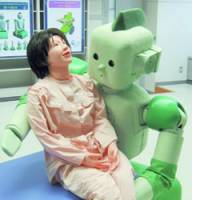Future robots that will someday provide services in such areas as nursing, security and cleaning will have to comply with safety guidelines planned by the Ministry of Economy, Trade and Industry.
METI officials said Saturday the guidelines will require manufacturers to install ample sensors to minimize the risk of the robots running into people and use soft lightweight materials so they do not cause harm if they do so.
They will also be required to install emergency shut-off buttons.
Calls have been mounting for safety guidelines because the next generation of robots may be pressed into action in large numbers because of the looming labor shortage stemming from Japan's sharp population decline.
While safety guidelines already exist under the Occupation Health and Safety Law for the current generation of robots, which are typically used on factory production lines, there is a need for different guidelines for the advanced models, the officials said.
METI plans to complete them by the end of the year.
It expects robot makers to develop specifications under the guidelines after consulting with users at hospitals, event sites and other areas.
METI will also consider establishing an independent organization to conduct safety tests on robots and legal systems to provide insurance in case of accidents.
METI plans to have its measures reflect global standards now being hammered out.



